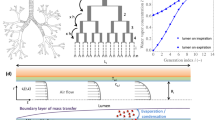Abstract
In order to provide a means for analysis of heat, water, and soluble gas exchange with the airways during tidal ventilation, a one dimensional theoretical model describing heat and water exchange in the respiratory airways has been extended to include soluble gas exchange with the airway mucosa and water exchange with the mucous layer lining the airways. Not only do heat, water, and gas exchange occur simultaneously, but they also interact. Heating and cooling of the airway surface and mucous lining affects both evaporative water and soluble gas exchange. Water evaporation provides a major source of heat exchange. The model-predicted mean airway temperature profiles agree well with literature data for both oral and nasal breathing validating that part of the model. With model parameters giving the best fit to experimental data, the model shows: (a) substantial heat recovery in the upper airways, (b) minimal respiratory heat and water loss, and (c) low average mucous temperatures and maximal increases in mucous thickness. For resting breathing of room air, heat and water conservation appear to be more important than conditioning efficiency. End-tidal expired partial pressures of very soluble gases eliminated by the lungs are predicted to be lower than the alveolar partial pressures due to the absorption of the expired gases by the airway mucosa. The model may be usable for design of experiments to examine mechanisms associated with the local hydration and dehydration dynamics of the mucosal surface, control of bronchial perfusion, triggering of asthma, mucociliary clearance and deposition of inhaled pollutant gases.
Similar content being viewed by others
References
Box, G.E.P.; Hunter, W.G.; Hunter, J.S. Statistics for experimenters, New York: John Wiley & Sons; 1978.
Baile, E.M.; Dahlby, R.W.; Wiggs, B.R.; Parsons, G.H.; Pare, P.E. Effect of cold and warm dry air hyperventilation on canine airway blood flow. J. Appl. Physiol., 62:526–532; 1987.
Cole, P. Further observations on conditioning of respiratory air. J. Laryngol. Otol., 67:669–681; 1953.
Coughanowr, D.R.; Koppel, L.B. Process systems analysis and control. New York: McGraw-Hill; 1965.
Deal, E.C., Jr.; McFadden, E.R., Jr.; Ingram, R.H., Jr.; Jaeger, J.J. Esophageal temperature during exercise in asthmatic and nonasthmatic subjects. J. Appl. Physiol., 46:484–490; 1979.
Felder, R.M.; Rousseau, R.W. Elementary principles of chemical processes. New York: John Wiley & Sons; 1978.
Hanna, L. M. Modelling of heat and water vapor transport in the human respiratory tract (Ph.D. diss.), Philadelphia, University of Pennsylvania; 1983.
Hanna, L.M.; Scherer, P.W. Regional control of local airway heart and water vapor losses. J. Appl. Physiol. 61:624–632; 1986.
Hindmarsh, A. LSODE, (computer program). Lawrence Livermore Laboratory; 1981.
Holman, J.P. Heat transfer, 5th ed. New York: McGraw-Hill; 1981.
Ingelstedt, S. Studies on conditioning of air in the respiratory tract. Acta Otolaryngol. Suppl. 131:1–80, 1956.
Ingenito, E.P. Respiratory fluid mechanics and heat transfer (Ph.D. diss.) Cambridge, Massachusetts Institute of Technology; 1984.
Ingenito, E.P.; Solway, J.; McFadden, E.R., Jr.; Pichurko, B.M.; Cravalho, E.G.; Drazen, J.M. Finite difference analysis of respiratory heat transfer. J. Appl. Physiol. 61:2252–2259; 1986.
Jones, A.W. Determination of liquid/air partition coefficients for dilute solutions of ethanol in water, whole blood, and plasma. J. Analytical Toxicology. 7:193–197; 1983.
Kruse, K.L. Heat and water transport dynamics in the respiratory tract (M.S. thesis). Cleveland, Case Western Reserve University; 1981.
McEvoy, R.D.; Davies, N.J.H.; Mannino, F.L.; Prutow, R.J.; Schumacker, P.T.; Wagner, P.D.; West, J.B. Pulmonary gas exchange during high-frequency ventilation. J. Appl. Physiol.:Respirat. Environ. Exercise Physiol. 52:1278–1287; 1982.
McFadden, E.R.; Pichurko, B.M.; Bowman, H.F.; Ingenito, E.; Burno, S.; Dowling, N.; Solway, J. Thermal mapping of the airways in humans, airway temperature during respiration. J. Appl. Physiol. 58:564–570; 1985.
Netter, F.H. The CIBA collection of medical illustrations, vol. 7, respiratory system. Summit, NJ: Ciba Pharmaceutical Company; 1979.
Reid, R.C.; Sherwood, T.K.; Prausnitz, J.M. The properties of gases and liquids, 3rd ed. New York: McGraw-Hill; 1980.
Robertson, H.T.; Coffey, R.L.; Standaert, T.A.; Truog, W.E. Respiratory and inert gas exchange during high-frequency ventilation. J. Appl. Physiol.: Respirat. Environ. Exercise Physiol. 52:683–689; 1982.
Saidel, G.M.; Kruse, K.L.; Primiano, F.P., Jr. Model simulation of heat and water transport dynamics in an airway. J. Biomech. Eng. 105:189–193; 1983.
Solway, J.; Pichurko, B.M.; Ingenito, E.P.; McFadden, E.R., Jr.; Fanta, C.H.; Ingram, R.H., Jr.; Drazen, J.M. Breathing pattern affects airway wall temperature during cold air hyperpnea in humans. Am. Rev. Respir. Dis. 132:853–857; 1985.
Tam, P.Y.; Verdugo, P. Control of mucus hydration as a donnan equilibrium process. Nature, 292:340–342; 1981.
Treybal, R.E. Mass transfer operations. New York: McGraw-Hill; 1980.
Tsu, M.E. Mathematical and experimental modeling of heat, water, and soluble exchange in the trachea (M.S. thesis), Seattle, University of Washington; 1986.
Vander, A.J.; Sherman, J.H.; Luciano, D.S. Human physiology: mechanisms of body function. New York: McGraw-Hill; 1985.
Varene, P.; Ferrus, L.; Manier, G.; Gire, J. Heat and water respiratory exchange comparison between mouth and nose breathing in humans. Clinical Physiol., 6:405–414, 1986.
Verdugo, P. Hydration kinetics of exocytosed mucins in cultured secretory cells of the rabbit trachea: a new model. In: Nugent, J.; O'Conne, M., eds. Mucus and mucosa. London: Pittman; 1984, pp. 212–225.
Wagner, P.D., Saltzman, H.A.; West, J.B. Measurement of continuous distribution of ventilation-perfusion ratio: theory. J. Appl. Physiol. 36:588–599; 1974.
Weibel, E. Morphometry of the human lung. New York: Springer-Verlag, 1963.
Author information
Authors and Affiliations
Additional information
This work was supported in part by Grant No. HL24163 of the National Institutes of Health.
Rights and permissions
About this article
Cite this article
Tsu, M.E., Babb, A.L., Ralph, D.D. et al. Dynamics of heat, water, and soluble gas exchange in the human airways: 1. A model study. Ann Biomed Eng 16, 547–571 (1988). https://doi.org/10.1007/BF02368015
Received:
Revised:
Issue Date:
DOI: https://doi.org/10.1007/BF02368015




